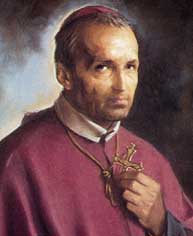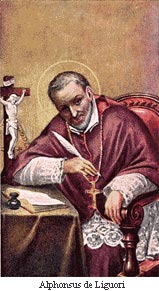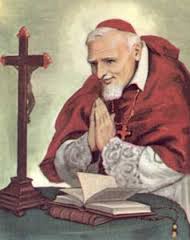
Summary: St Alphonsus Ligouri, Bishop, Doctor of the Church. Born at Naples (Italy) in 1696; died at Nocera on this day in 1787. After founding the Congregation of the Most Holy Redeemer (Redemptorists), he was for thirteen years bishop of Sant’ Agata dei Goti, but resigned due to ill health. He coped with much internal conflict within the congregation and external opposition. Honoured as a popular preacher and devotional writer and as an influential master of moral theology.
Patrick Duffy tells his story.
 Alphonsus can be a patron for many different kinds of people. Because of a resolution he made and lived up to never to waste time, procrastinators can pray to him. He often suffered from scruples. His preaching and his writings caused dissension among the people and there were difficulties and divisions in his order that weren’t sorted out till after his death. In his later years he suffered badly from arthritis. And still he was a really holy man.
Alphonsus can be a patron for many different kinds of people. Because of a resolution he made and lived up to never to waste time, procrastinators can pray to him. He often suffered from scruples. His preaching and his writings caused dissension among the people and there were difficulties and divisions in his order that weren’t sorted out till after his death. In his later years he suffered badly from arthritis. And still he was a really holy man.
Failure led him to a Change
A high profile legal case led to him give up his practice as a lawyer. Alphonsus was born at Marianella near Naples. His father was a captain in the navy of the King of Naples and his mother was of Spanish descent. They ensured that Alphonsus had a good education at home in languages, the humanities, philosophy and the arts. He loved to play the harpsichord. By seventeen, he earned a double doctorate in canon and civil law from the University of Naples and began practising as a lawyer. However, an oversight and consequent failure in a high profile case on behalf of the Orsini against the Grand Duke of Tuscany led him to giving up his legal practice.
Ordained 1726
Alphonsus decided to become a priest and his father though opposed at first reluctantly agreed, provided he didn’t join the Oratorians. Alphonsus was ordained a secular priest in 1726 and three years later he became a chaplain in a college for training missionaries. There he met Thomas Falcoia, who sent him to investigate a nun who had a vision and who wanted to found a new congregation – the Redemptoristines. Alphonsus declared the vision authentic and the order was founded.
Congregation of the Most Holy Redeemer
Two years later, Falcoia, who by now had become a bishop, asked Alphonsus to start a congregation of missionaries to work among the people in the rural districts around Naples. This congregation had some difficulties in having its rule approved as Alphonsus sought permission from the King of Naples and not from Church authorities. Eventually in 1749 the Congregation of the Most Holy Redeemer was approved by Pope Benedict XIV (Prospero Lambertini 1740-58). But the difficulties and divisions within the order were not resolved until after Alphonsus had died.
Preaching Missions
From almost forty years Alphonsus preached in the area around Naples and became much sought after as a confessor and spiritual director. He was both strict and compassionate.

His aim in his preaching, spiritual direction and moral was to be as gentle, simple, and intelligible as he could. But he could also use the rhetorical power of persuasion he had developed as a lawyer. One Sunday with a black stole and a flaming torch he is said to have delivered a hair-raising sermon on the day of judgement and the fires of hell.
Built a Monastery and a Seminary
Alphonsus built a monastery to serve as a retreat centre and a seminary to meet the growing demand for his missionaries.
 Theological/Devotional writings
Theological/Devotional writings
In 1745 he published the first of his many theological and devotional works. His Moral Theology counteracted both rigorism and laxism insisting it was lawful to follow the milder of two equally probable opinions. His views on the primacy of conscience led to a renewal of moral theology in the post Vatican II era.
Bishop of Sant’Agatha dei Goti
In 1762 – he was already sixty-six years of age – Alphonsus was named as bishop the diocese of Sant’Agatha dei Goti (between Naples and Capua). Here he campaigned tirelessly to reform the clergy, get them to observe the rule of celibacy, celebrate the Mass reverently, and preach in simple language to the people. During this time he suffered bouts of arthritis, sciatica and a curvature of his spine.
 Retirement
Retirement
In 1775 when Alphonsus was able to have his resignation accepted, he went to live at Nocera dei Pagani, his favourite Redemptorist house. Here he spent most of his time writing. He lived till he was ninety-one, but during his last months he suffered periods of dementia and towards the end suffered from dysentery, gangrene and uremia.
Death and Influence
As he lay dying his confreres brought him a picture of his friend and lay brother in the Redemptorists St Gerard Majella, but Alphonsus muttered: “Even he cannot save me now”. He died in 1787 and was canonised in 1839. In March 1871, Pius IX declared him a Doctor of the Church, and in 1950, Pius XII declared him the official patron of moralists and of confessors.
+++++++++++++++++++++++++++++
******************************
Memorable Proverb for today
If you embrace all things in this life
as coming from the hands of God,
and even embrace death to fulfil His holy will,
assuredly you will die a saint.
~ St Alphonsus Ligouri ~
**********************************